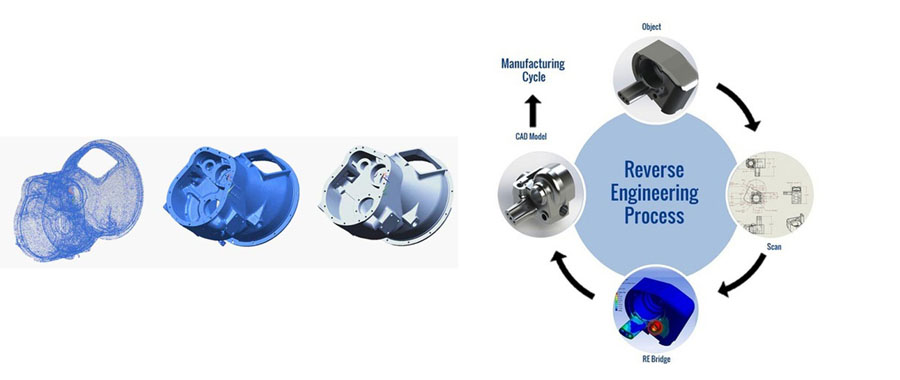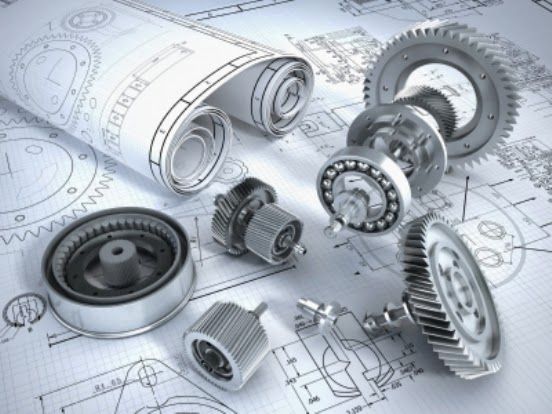What Is Reverse Engineering?
Reverse engineering is the process of examining existing products to determine detailed information and specifications to understand how they are manufactured and how they work. For example, many old parts used in the machine have withstood the test of time. When a component fails or is completely damaged, the component can be replaced instead of the entire device. A process called reverse engineering makes it possible to replace these parts.
For mechanical assembly, this usually involves disassembling, then analyzing, measuring, and recording the parts. Reverse engineering is not limited to mechanical parts or components. Electronic components and computer programs (software) as well as biological, chemical and organic matter can also be reverse engineered
In mechanical engineering, the term reverse engineering (usually abbreviated as RE) is used to summarize the process of reconstructing existing objects. When designing an object from scratch, the engineer will draft the design specifications and generate the drawings used to construct the project. On the contrary, in reverse engineering, design engineers start from the final product and then complete the design process in the opposite direction to arrive at product design specifications. In the process, important information about design concepts and manufacturing methods was discovered.
The Reverse Engineering Process

In order to reverse-engineer physical products, organizations will usually take samples of the products involved and disassemble them to examine their internal mechanisms. In this way, engineers can disclose information about the original design and construction of the product. When performing reverse engineering on mechanical products, the first thing to do is to analyze the size and attributes of the products involved, whether it is airplanes, ships, vehicles, computers or industrial machinery parts. During this analysis, you need to measure the width, length and height of the key components in the product, because these dimensions are usually related to the performance of the product.
Nowadays, some engineers use 3D scanning technology to make such measurements. With the help of a 3D scanner, engineers can accurately read product specifications and automatically record this information in their database. 3D scanning technology includes coordinate measuring machine (CMM), industrial computer tomography (CT) scanner, laser scanner and structured light digitizer.
After collecting and recording all relevant information, you can use this data to create computer-aided design (CAD) drawings for subsequent analysis and development. CAD engineering drawings are two-dimensional and three-dimensional digital representations of products, and you can use them to analyze product designs. These digital models help reveal design intent and provide information for the creation of reverse engineered components.
Compared with the original model, the accuracy of the captured data will affect the quality and deviation of the reverse engineering model. Then pass the captured surface data to the internal design team to establish the original design intent of the object.
What Is Reverse Engineering Used For?

Reverse engineering provides manufacturers with information about product or component design. Upon successful completion, reverse engineering will provide you with a virtual copy of the blueprint into the original design. Reverse engineering is perhaps the most accurate method to recreate the design of a product that was discontinued decades ago. If the original blueprint has been lost or destroyed for a long time, then reverse engineering may be the only way to bring such products back to life. If a working model of an old product is available, it is usually possible to track its design steps and use these insights to build new models, repair parts or improve future products. The following are some of the most common uses of reverse engineering.
1. Legacy Parts Replacement
One of the most common applications of reverse engineering is the replacement of old parts, which involves checking and copying selected parts of a larger machine to keep it running. If the machine is old, some parts may no longer be produced. Through reverse engineering, you can use a 3D scanner to digitally copy the design of the defective part. From there, you can create a new copy of the component and install it on your computer. Depending on the size and complexity of the relevant components, the initial cost of reverse-engineering them may exceed the price of updates or different models. However, once you have created a digital copy of the original design and successfully copied the part, you can use this information to recreate the assembly again and again. Reverse engineering allows you to copy parts that work in your preferred mechanical settings, regardless of whether the original manufacturer is still in business.
2. Parts Service Or Repair
The data you get from reverse engineering If the old parts or components that the OEM no longer supports need repair or service, it will be useful to understand how the product works. This knowledge can help you complete repairs accurately and efficiently. If there are no design documents available, companies can use reverse engineering to create them. You can then use this information to inform you how to repair or maintain the part. The data obtained from reverse engineering can help you determine which components need to be replaced to solve a particular problem. It can also help you better understand how to best access, remove and replace a part, thereby providing information for your repair process.
3. Failure Analysis
Reverse engineering technology can play an important role in failure analysis. If the machine fails, you may need to disassemble it or check the design documents to determine the cause. Once you have this information, you will know how to repair or improve the product to make it work again. Using reverse engineering to check the product can find damaged parts of the wrong design. Viewing digital design files created through reverse engineering can also spot defects and help inform you about how you plan to repair your equipment.
4. Part Improvement
Reverse engineering is also used for part improvement. After the failure analysis, you may need to change the components, or it may only be the components required for the upgrade. If no replacement or replacement parts are available on the market, the parts can be reverse engineered to create a copy of the original design.
5. Diagnose And Solve Problems.
Reverse engineering can also be used for diagnosis and problem solving in a series of industrial processes. In the factory settings, the operation process sometimes slows down due to malfunctions or poor performance. When a manufacturing system consists of many machines and components, it may be difficult to determine the source of the problem. Through reverse engineering, you can determine how everything works together and use this knowledge to determine where things can be done wrong.
6. Competitor Analysis
Any organization can analyze competitors’ products through reverse engineering.
7. Digital Archiving
Museum objects and historical relics can be captured by 3D scanning, and then reverse engineered, and the generated CAD data can be retained to prevent any damage to the object in the future or any part of the object that needs to be copied.


